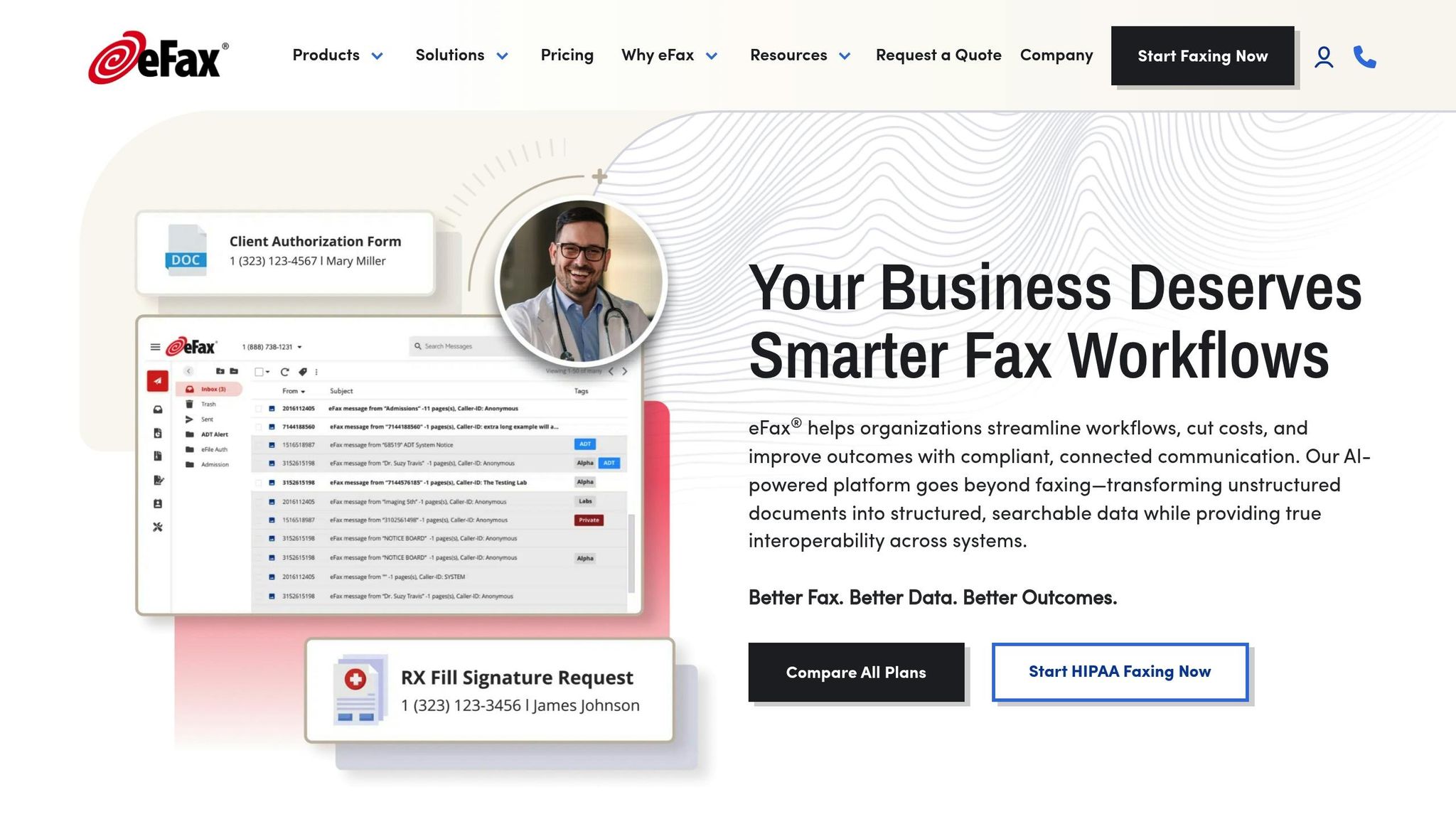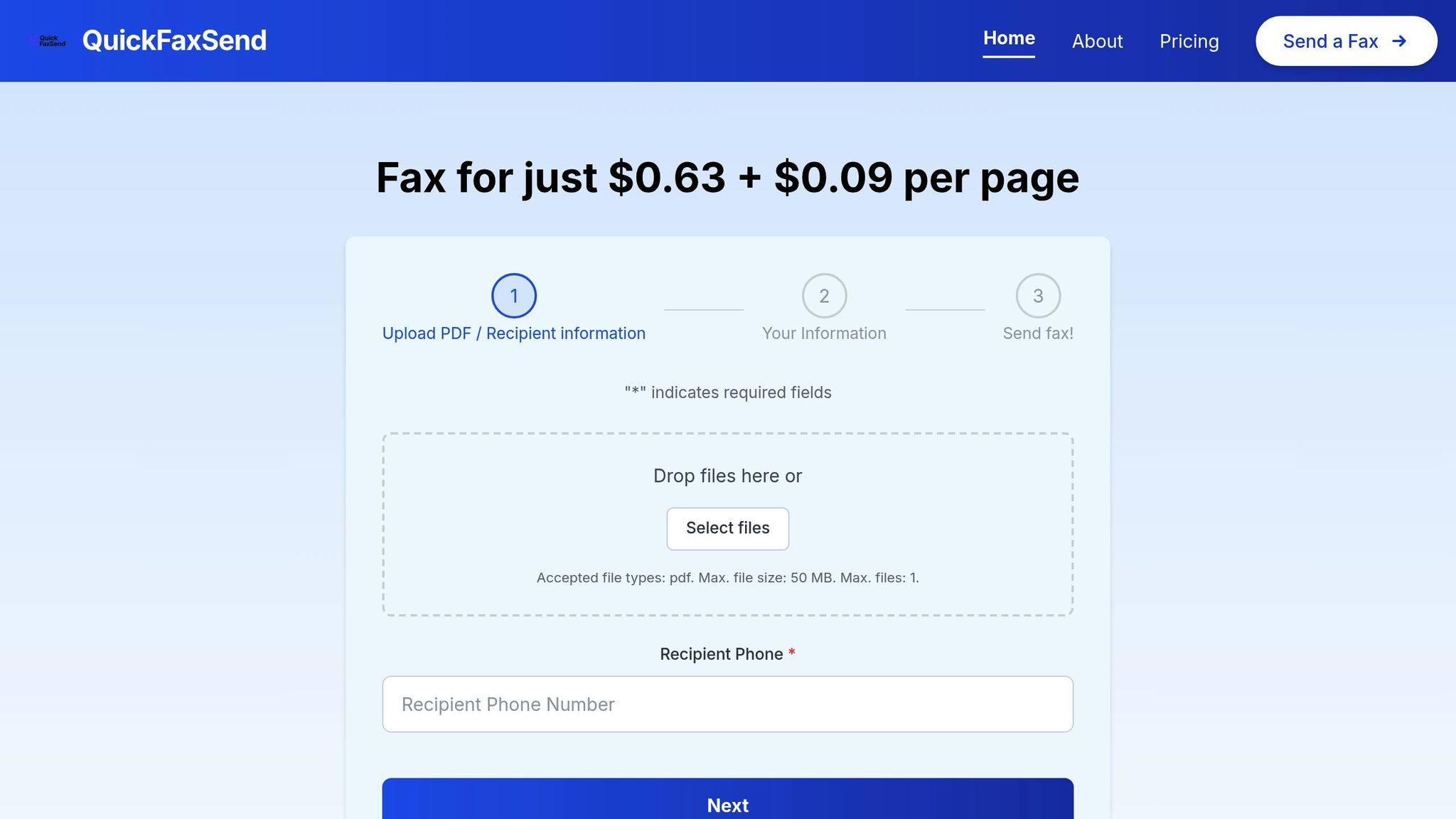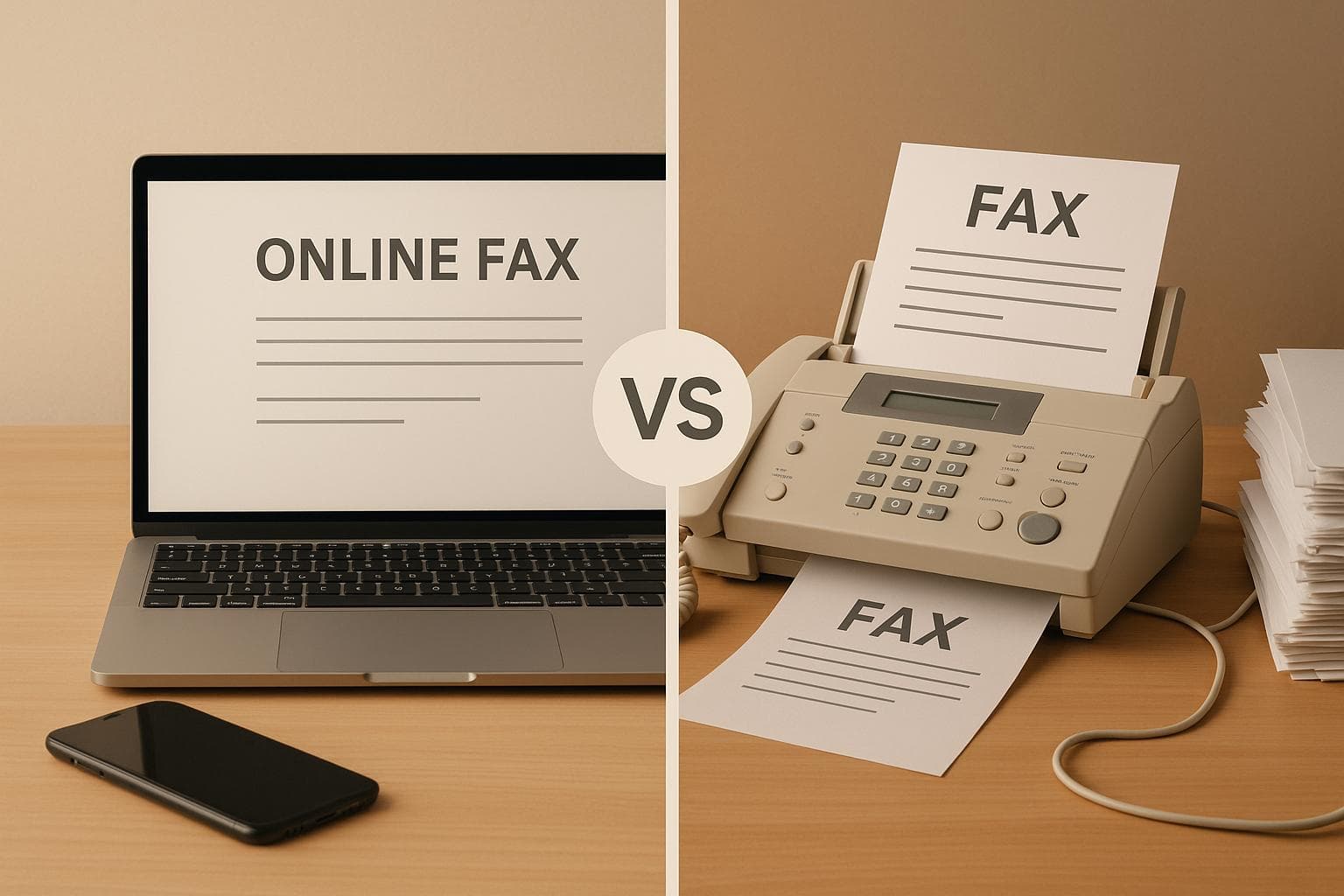Online Fax vs Traditional Fax: Which is Better?
In 2024, the fax market was worth $3.3 billion and is projected to hit $4.47 billion by 2030. Despite the rise of digital tools, 17% of businesses still use fax, with 43 million machines operating globally. But which is the better option for businesses today - online fax or traditional fax?
Here’s the quick answer: Online faxing outshines traditional faxing in cost, convenience, security, and flexibility. Traditional faxing requires expensive hardware, dedicated phone lines, and regular maintenance, while online faxing eliminates these hassles by using the internet. It’s also more secure, mobile-friendly, and better for reducing waste.
Key Takeaways:
- Cost: Online faxing is far cheaper, with pay-as-you-go options like QuickFaxSend costing $0.63 + $0.09 per page, compared to traditional faxing’s upfront hardware costs ($100–$1,000) and monthly fees ($20–$60).
- Convenience: Online faxing allows you to send/receive documents from any device, anywhere - no bulky machines or physical presence required.
- Security: Online faxing offers encryption and compliance-ready features, unlike paper-based faxes that can sit exposed in trays.
- Environment: Online faxing eliminates paper and toner use, reducing waste and energy consumption.
Quick Comparison:
| Factor | Online Faxing | Traditional Faxing | | --- | --- | --- | | Setup Cost | Minimal (internet) | High ($100–$1,000) | | Ongoing Costs | Pay-per-use or low | High (supplies, phone) | | Mobility | Any device, anywhere | Limited to office | | Security | Encrypted, compliant | Paper-based risks | | Eco Impact | Paperless, low waste | High paper/toner usage |
If your business values cost savings, mobility, and secure document handling, online faxing is the clear choice.
EFax vs Fax Machine: Making the Right Choice for Modern Communication

::: @iframe https://www.youtube.com/embed/hoFaj6VeHX8 :::
Costs and Setup Requirements
When comparing faxing methods, the financial differences are striking. Traditional faxing often involves hefty upfront investments and recurring costs, while online faxing offers a simpler, more cost-effective alternative. Let’s break down how each option impacts your budget.
Traditional Fax Expenses
Traditional fax machines come with a range of upfront and ongoing costs. For starters, purchasing a basic fax machine can set you back anywhere from $100 to $500, while high-volume models often cost between $500 and $1,000 [2]. And that’s just the beginning.
Monthly service fees for a dedicated phone line typically run between $20 and $50, with high-volume users paying slightly more - around $25 to $60 per month [2]. Supplies like toner cartridges, which cost $30 to $150 each, and paper, priced at $5 to $10 per ream, add another layer of expense [3]. If your business sends multiple faxes every week, these costs can pile up quickly.
Then there’s maintenance. Standard machines require annual upkeep costing $50 to $200, while high-volume machines may demand $200 to $1,000 annually [2]. These unpredictable expenses can make traditional faxing a financial headache.
| Cost Category | Traditional Fax (Standard) | Traditional Fax (High-Volume) | | --- | --- | --- | | Hardware Costs | $100 to $500 | $500 to $1,000 | | Monthly Service Fees | $20 to $50 | $25 to $60 | | Annual Maintenance | $50 to $200 | $200 to $1,000 |
Online Fax Cost Benefits
Online faxing offers a modern, cost-efficient approach. Take QuickFaxSend, for example. With its $0.63 plus $0.09 per page pricing model, you only pay for what you use - no monthly subscriptions or equipment purchases required.
Switching to online faxing can save businesses up to 400% annually compared to traditional faxing [2]. For instance, a business sending 50 pages a month would spend just $5.13 monthly with QuickFaxSend. Compare that to the $55 to $150 monthly costs of traditional faxing, including phone lines, supplies, and maintenance, and the savings become crystal clear.
Beyond the financial perks, online faxing is incredibly easy to set up. All you need is an internet connection and a device like a computer, smartphone, or tablet. There’s no need for dedicated phone lines, bulky hardware, or constant supply management. Plus, because online faxing doesn’t require printing or scanning, it’s a far more streamlined process.
Predictable costs are another major advantage. By eliminating maintenance fees and unexpected equipment failures, online faxing makes budgeting much simpler. This transparency allows businesses to plan their finances more effectively.
"Online faxing is much faster and eliminates the downtime that you might spend waiting to send or receive a fax through a physical fax machine and landline." – Team AccuRoute, AccuRoute [5]
For businesses looking to cut costs and boost efficiency, online faxing is a clear winner. It removes the need for hardware, maintenance, supplies, and dedicated phone lines, delivering significant savings and a hassle-free experience.
Security and Compliance
Protecting sensitive documents is a top priority for businesses, and the gap in security between traditional and online faxing is hard to ignore. Modern online fax services offer encryption and compliance measures that traditional faxing simply can't match, making them a smarter choice for handling confidential information.
Online Fax Security Features
Online faxing takes security seriously by using 256-bit SSL encryption and secure PDF transmission with built-in delivery confirmations [6]. This ensures that sensitive documents remain protected from prying eyes and unauthorized access.
Take QuickFaxSend as an example - it provides secure PDF transmission with delivery confirmations, guaranteeing that your documents reach the right recipients without compromise. Compare this to traditional faxing, where papers can sit unattended in output trays, exposing them to potential breaches. Online faxing keeps your data protected at every step of the process.
Another major advantage is cloud storage. Online fax services enable secure archiving and retrieval of sent and received documents, eliminating the need for physical filing cabinets that could be accessed by unauthorized individuals [6]. This added layer of security is essential for businesses managing sensitive information. Plus, these security measures align seamlessly with U.S. regulatory standards.
Meeting U.S. Regulatory Requirements
For industries like healthcare, compliance with regulations such as HIPAA is non-negotiable. The HIPAA Security Rule demands administrative, physical, and technical safeguards to protect electronic protected health information (ePHI) [8]. Online fax services are built with these requirements in mind, offering digital tracking and security features that traditional faxing can't provide.
The stakes are high - a data breach costs an average of $4.45 million, and 66% of consumers would stop supporting a business after such an incident [9]. By integrating compliance features, online faxing helps businesses avoid these costly scenarios while maintaining trust with their clients.
But security and compliance aren't the only benefits. Reliability is just as critical for smooth business operations.
Performance and Reliability Comparison
Traditional fax machines are notorious for reliability issues. Paper jams, busy signals, and toner shortages can bring operations to a standstill. Add to that the risks of manual errors, like dialing the wrong number or sending documents to unintended recipients, and it's clear that traditional faxing has its flaws.
Online faxing eliminates these headaches. Documents are sent digitally, with automatic retries if the first attempt fails. Delivery confirmations provide instant proof that your fax reached its destination. No more wondering if your document made it through.
Real-world examples highlight these benefits. The McCabe Group improved its workflows by switching to digital faxing. A regional bank enhanced data security through cloud faxing, and law firm Duane Morris LLP increased efficiency across its 24 offices by moving away from outdated fax servers [7].
Another key advantage is reduced human intervention. Traditional faxing requires staff to physically manage machines, replace supplies, and handle documents multiple times - each step increasing the risk of mistakes or security breaches. Online faxing minimizes these touchpoints, focusing only on document preparation and transmission. This not only reduces errors but also strengthens security.
For businesses that value both security and reliability, online faxing is the clear winner. Its advanced encryption, built-in compliance features, and freedom from mechanical failures make it the superior solution for modern document transmission.
sbb-itb-7cae838
User Experience and Access
Online faxing has revolutionized how businesses handle document transmission, making operations smoother and more efficient. Unlike traditional faxing, which ties you to a specific location, online faxing gives you the freedom to send and receive documents from virtually anywhere - whether you're working from home, at the office, or traveling.
Online Fax Convenience
With online fax services, you can use computers, smartphones, or tablets to manage your fax communications. This flexibility means you're no longer tethered to a bulky fax machine in a fixed location. Email integration takes convenience a step further, allowing you to send and receive faxes through platforms you're already familiar with.
"Users can use email to send and receive faxes from any location, on any device." – GFI FaxMaker Online [11]
Take QuickFaxSend, for example. Their web-based interface simplifies the entire process: upload a PDF, enter the recipient's details, and hit send - all in just a few clicks. Whether you're at a coffee shop with your laptop or on a business trip using your smartphone, the experience remains seamless and efficient.
Many online fax providers also offer mobile apps, ensuring that professionals can handle urgent documents while on the move [7][10]. This level of mobility is invaluable for those who need to stay productive outside of a traditional office setting, saving both time and effort.
Time Savings
The time saved by switching from traditional to online faxing is considerable. Traditional faxing often involves multiple manual steps - printing, dialing, waiting for confirmations - that eat up valuable time. Online faxing eliminates these inefficiencies, letting you complete the process in just minutes.
For instance, QuickFaxSend streamlines the workflow: upload your document, enter the recipient's fax number, and send. The system takes care of delivery and even provides a confirmation, removing much of the guesswork and frustration.
Real-world feedback underscores these benefits:
"GFI FaxMaker Online allowed us to eliminate fax machines, paper, toner, service contracts and maintenance, and brought a quick and easy solution for our employees." [11]
Beyond saving time, online faxing also simplifies document management. Automated digital filing means you no longer need to sift through piles of paper to find what you need.
The pay-per-use pricing model offered by QuickFaxSend is another time-saver. At just $0.63 plus $0.09 per page, you avoid the hassle of managing subscriptions or worrying about usage limits - pay only for what you use.
Environmental Impact
The contrast between traditional faxing and online faxing when it comes to environmental impact is hard to ignore. While traditional fax machines contribute to office waste and consume significant energy, online faxing offers a cleaner, more efficient alternative that aligns with today’s push for greener practices.
Paper and Energy Use
Traditional faxing creates a heavy burden on the environment. For example, U.S. offices throw away over 18 billion pounds of paper every year [12]. Paper alone makes up about 26% of landfill waste [13], and the U.S. Small Business Administration reports that the average office worker uses nearly 10,000 sheets of paper annually [12]. On top of that, about 42% of the global wood harvest is dedicated to paper production [14]. And it’s not just the paper - traditional fax machines also need toner cartridges, replacement parts, and dedicated phone lines, all of which add to their environmental footprint.
Online faxing eliminates all of these issues. Since documents are transmitted digitally, there’s no need for paper, toner, or any extra hardware beyond an internet connection. Additionally, digital faxing consumes far less energy compared to the processes involved in producing and handling paper documents [14].
Here's a quick comparison of resource usage between digital and traditional faxing:
| Feature | Digital Faxing | Traditional Fax Machines | | --- | --- | --- | | Paper & Toner | No | Yes | | Environmental Impact | Low waste, eco-friendly | High paper, ink, and energy use |
Even a modest reduction in paper use - just 5% annually - could save 360 million gallons of water [13]. That’s a clear indication of the conservation potential when transitioning to digital solutions.
Supporting Business Sustainability
The resource savings from online faxing don’t just benefit the environment - they also support broader sustainability efforts within businesses. Moving to digital faxing can simplify operations and cut costs, with the average upkeep for a traditional fax machine exceeding $600 per year [12]. Beyond cost savings, digital faxing helps businesses identify and reduce wasteful workflows, promoting more efficient and environmentally friendly practices [12][13].
For companies committed to sustainability or aiming for certifications like LEED, adopting online faxing delivers measurable benefits. It’s a practical step toward achieving green business goals while reducing environmental impact.
Choosing the Right Fax Method
Balancing cost, security, accessibility, and environmental impact is key when deciding between online and traditional faxing for your business. The right choice depends entirely on your specific needs and priorities.
Factors to Consider
When comparing fax solutions, a few critical factors should guide your decision:
-
Cost: The financial aspect is often the first consideration. As highlighted earlier, traditional faxing comes with higher setup costs (fax machines, phone lines, and supplies), while online faxing typically involves subscription fees or pay-per-use pricing. For instance, online services charge around $0.49–$0.98 per page for business users, making it easy to estimate costs based on usage [1]. Businesses with lower fax volumes may find pay-per-use models economical, while high-volume users might benefit from subscription plans.
-
Document Volume and Frequency: The number of faxes you send and how often you send them can influence your choice. Online faxing offers flexibility, catering to both occasional and frequent users.
-
Security and Compliance: Industries like healthcare, legal, and finance often require secure and compliant faxing solutions. Online faxing excels here, offering encryption, audit trails, and compliance-ready features [5].
-
Accessibility and Mobility: For teams working remotely or outside standard office hours, online faxing offers unmatched convenience. You can send and receive faxes from virtually any device with internet access [4]. Traditional faxing, on the other hand, ties you to a physical machine.
-
Environmental Impact: Online faxing supports eco-friendly practices by eliminating paper and reducing energy use. Traditional faxing, with its reliance on paper and toner, has a much larger environmental footprint.
Here's a quick comparison to help you weigh your options:
| Factor | Online Faxing | Traditional Faxing | | --- | --- | --- | | Setup Cost | Minimal (internet connection) | High (machine, phone line, supplies) | | Ongoing Expenses | Subscription or per-page fees | Paper, toner, maintenance, phone line | | Security | Encryption, audit trails, compliance-ready | Paper output, physical security risks | | Accessibility | Any device, anywhere | Office location only | | Environmental Impact | Paperless, eco-friendly | High paper and energy consumption |
Why QuickFaxSend Stands Out

QuickFaxSend simplifies faxing by combining cost-effectiveness, security, and flexibility into one seamless package. With a pay-per-use model priced at $0.63 plus $0.09 per page, you only pay for what you need - perfect for businesses of all sizes.
The platform ensures secure document transmission with delivery confirmations and audit trails, meeting compliance requirements for industries like healthcare and finance. You can upload PDFs and send faxes from any device with an internet connection, making it ideal for remote teams and businesses that value mobility.
FAQs
::: faq
How does online faxing keep sensitive documents secure compared to traditional faxing?
Online faxing takes document security to the next level with features like encryption, secure transmission protocols, and multi-factor authentication. These tools work together to safeguard your sensitive information, reducing the risks of unauthorized access. Unlike traditional fax machines, which can be prone to interception or human mistakes, online faxing ensures a more secure way to transmit important documents.
Many online fax services also offer additional safeguards, such as audit trails, role-based permissions, and built-in tools to help meet regulatory requirements. For businesses that handle confidential information, these features make online faxing a dependable option for maintaining security and compliance. :::
::: faq
What are the environmental advantages of using online faxing instead of traditional faxing?
Switching to online faxing comes with several eco-friendly perks that can help your business shrink its environmental impact. For starters, it eliminates the need for paper, ink, and toner. This means fewer natural resources are used, less waste is generated, and there’s a positive impact on forest preservation and landfill reduction.
On top of that, online faxing cuts out the energy consumption tied to running physical fax machines. This reduction in energy use helps lower greenhouse gas emissions, making it a smarter option for businesses aiming to adopt greener, more responsible practices. :::
::: faq
How can businesses decide if online faxing's pay-per-use model is more cost-effective than traditional faxing?
Businesses looking to see if online faxing's pay-per-use model is easier on the budget should take a close look at their current faxing expenses. This means factoring in costs for hardware, paper, ink, and maintenance. Traditional faxing tends to come with higher upfront and ongoing expenses, while online faxing skips the need for physical equipment and supplies - potentially cutting operational costs by as much as 70%.
For companies that only fax occasionally or have moderate needs, the pay-per-use option can be a smart choice. It eliminates the fixed costs tied to owning and maintaining traditional fax machines. By analyzing their monthly fax volume and comparing it to the rates from online faxing services, businesses can decide which option works best for their budget and communication requirements. :::
